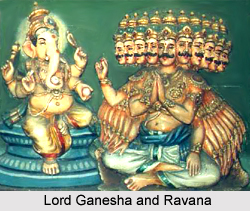 The legend of Lord Ganesha and Ravana can be traced back to the period of the Ramayana. Ravana, the ruler of Lanka, wanted to acquire immortality by attaining the Soul of Shiva, known as the Atma Linga (Atma Lingam). Thus Ravana engaged in intense worship or tapasya of Lord Shiva as the Atma Linga belonged to the lord of destruction. Lord Shiva announced that he would bless Ravana with whatever he desires as the god was pleased by his devotion. But due to the intervention of Lord Vishnu and Sage Narada, Ravana, the demon king, asked for Goddess Parvati. Thus Lord Shiva presented Ravana with Parvati (Uma).
The legend of Lord Ganesha and Ravana can be traced back to the period of the Ramayana. Ravana, the ruler of Lanka, wanted to acquire immortality by attaining the Soul of Shiva, known as the Atma Linga (Atma Lingam). Thus Ravana engaged in intense worship or tapasya of Lord Shiva as the Atma Linga belonged to the lord of destruction. Lord Shiva announced that he would bless Ravana with whatever he desires as the god was pleased by his devotion. But due to the intervention of Lord Vishnu and Sage Narada, Ravana, the demon king, asked for Goddess Parvati. Thus Lord Shiva presented Ravana with Parvati (Uma).
But Sage Narada informed the ruler of Lanka that Shiva had not presented him with Parvati, but with an imposter. The real Goddess Parvati was present in Pathala. Thus Ravana leaves the imposter and goes to Pathala to marry the daughter of the ruler, who he believed to the real Parvati. Later after the demon king realizes that he was tricked by Narada and Vishnu, Ravana asks for forgiveness from Lord Shiva and prays to him. Shiva again grants him a boon and Ravana asks for the Atma Linga. The lord presents him with the Linga, but gives the condition that it should never be kept on the ground. The power of the Atma Linga will go away from Ravana if it was placed on the ground. Ravana later went back to his Kingdom of Lanka with the Lingam.
Sage Narada prayed to Lord Ganseha to create obstacles for the demon king and prevent him from reaching Lanka, as Ravana may create utmost chaos after gaining immortality. Ganseha, also known as Vinayaka, decided foil the religious rituals performed by Ravana on a daily basis and seize the Atma Linga. Lord Vishnu blocked the sun and made it look like dusk as Ravana reached Gokarna. Ravana thought to prepare himself for performing the religious rituals, but was unable to conduct them as he held the Atma Linga.
Ganesha, in the incarnation of a simple Brahmin boy, approached Ravana and offered to help him by holding the Atma Linga while he performed his rituals. Ravana agreed and requested the boy not to keep the Linga on the ground. But Lord Ganesha said that he would call the demon king for three times and if Ravana failed to return in that time, then he would be compelled to keep the Atma Linga on the ground. As Ravana started to perform his rituals, the Brahmin boy called him thrice and Ravana failed to reach him within the set time. Thus, before Ravana could complete his daily rituals, Lord Ganesha kept the Atma Linga on the ground. Consequently Lord Vishnu made the sun re-appear and Ravana realized that he was tricked by the gods. In anger, he hit the Brahmin boy and attempted to destroy and uproot the Linga.
The ruler of Lanka, Ravana, had acquired the power of the Atma Linga by then and threw pieces of the Linga in various parts of the country. But Lord Ganesha proved to be more powerful and blessed. He subdued the demon king and kicked him away into the sky. Ravana realized the power of Ganesha and his own limitations. He then prayed to Ganesha for his forgiveness. The places where the pieces of the Atma Linga fell, were developed into sacred places, such as the Sadashiva temple in Surathkal; Sajjeshwara; Dhareshwara; Guneshwara; and Murudeshwar Temple (Mrideshwara) in Kanduka Hill.









